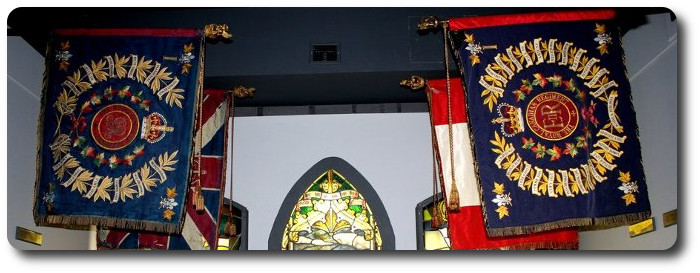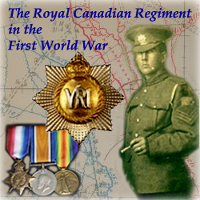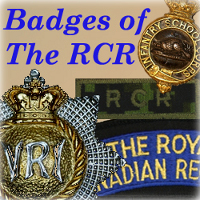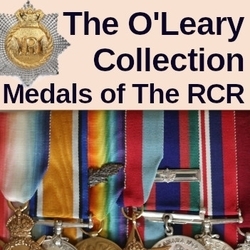
Researching The Royal Canadian Regiment
Veteran's Tales #2 - Toronto
Stanley Barracks in the 1930s
By: LCol Ted Shuter (Ret'd)
Following the summer camp in Niagara, B Coy The RCR returned each year to Stanley Barracks in Toronto. Stanley Barracks was located in the Exhibition grounds in Toronto, adjacent to the Automotive Building. Four main two story buildings formed a square, RCR on the East (this building was split in the middle with a large archway as the entrance to the barracks), RCD across the square to the West (right beside the roller coaster!) the Regimental HQ of the RCD to the North and the Officers Mess to the South on the Lakeshore Blvd. (This latter is the only building left standing after the war and is used as a restaurant). The RCD stables were hidden in one corner of their area and behind the RCR block were smaller buildings housing the tailor, shoemaker, QM stores and the Sgts Mess. The main buildings were at least 100 years old, plain, solid and rather grim in appearance. We lived 1-16 to a barrack room, all on the second floor, with the canteens (wet and dry), Orderly Rooms, Sergeants' room, mess hall, etc on the lower floors. Each man had a space just a couple of feet surrounding his cot, which had a thin mattress, blankets and SHEETS! These latter must be folded each morning just so, with the thin red strip of the sheets dead centre. Uniforms were hung exactly the same on pegs behind the cots, along with a rifle rest for .303 rifles - not locked! A barrack box at the foot of the bed was provided for spare kit. Downstairs was the washroom with a huge water tank heated by a coal stove. A night piquet had the joyless duty of keeping all these stoves, and the cook stove going during the night. The toilet was a large two-foot pipe, with seats on it and ever running water.
The floors were of unstained hardwood and on Friday nights we each had to scrub (hands and knees) our space for the inspection Saturday morning. Usually we were allowed off Saturday afternoon! Sunday was too often a church parade, the Catholics and Protestants in separate lots (no other religions permitted). We Protestants solemnly trudged out the gate, out the Princes' Gate to Bathurst St. and North to the old Garrison church there. Back again to a huge meal, usually roast pork, it was a feast! (I can smell it yet!) The dress for this was the old WWI uniform, shined buttons to the neck, (beavers on the collar) puttees to just below the knees, a peaked cap, the old four inch web belt with a shiny RCR buckle, and the old twelve inch bayonet. The web equipment was scrubbed weekly, then blancoed, and all the brass ends polished. One of our first duties on arriving in Barracks was to patrol the perimeter fence, and man the gate to beat off the curious public attending the Exhibition, particularly veterans dying of thirst who wanted to visit our canteen.
By carefully hoarding our $1.10 a day pay, or going into debt, we accumulated a civilian wardrobe: suits $24.00 each, tailor made at Tip Top Tailors. In our last year there, some smart officer (yes, there were some!) arranged for each of us to purchase a wardrobe trunk for $19.00 to house all this finery, and to stand between the cots. As an aside, those were stored during the war and returned to those who survived when we came home, mine still exists with my son in Ottawa.
Our parade square was a miniscule patch in front of the barracks so most of our training took place in the Fort York Armouries, just outside the Princes' Gates. This was also our basketball court. Here I had a fall on that unforgiving floor and broke my right wrist, a reverse break with the arm two inches higher than the hand. One dumb Cpl was dissuaded from pulling it out, and I was rushed to our Medical Officer who brilliantly diagnosed the problem with the statement "by God you have a broken wrist!" Off to Christie Street Hospital, and luckily a brilliant orthopaedic surgeon (Dr. Dale) who pieced the shattered bones together with some bone pegs in three operations. Six weeks later I was declared fit (almost 90% function) and returned to duty. My point of telling this is that the visit to Christie St. was an education. Here I met the wounded veterans of WWI, many minus various parts and one a paraplegic. From them I did learn what real courage meant as they underwent several serious operations. Here I learned to save, to invest money, to play several card games, and to teach, with guidance, a blind man how to cope. I returned to the Hospital many Sundays thereafter to visit these old and valued friends. The streetcar fare was 7 cents but I often walked the distance, ah youth!
During the winters, we had the various schools of Militia Officer training. Here again. Fort York was the main venue. One of the games was to teach them drill, company to battalion. For this game, we soldiers with long ropes became a full unit. The fun was when they were passing out. If the officer was a good egg (nice to his batman, etc) we executed the drill movement he was supposed to have ordered. If he was not in our good books, we did exactly what he ordered, chaos! A part of their education was how to conduct an Orderly Room parade. Again, we were the guinea pigs, and were marched in to the Company Commander with various dreamed up charges, supplications or complaints. I happened to have the job at one of these classes of applying for permission to marry (required in those days). This came back to haunt me years later when I was a Lt. Col. in North Bay, Ont. My wife was with me when one of those officers of the local unit asked if this was the girl I had proposed to back in 1936 (I was married in 1946). I had a job explaining that one to him - and to my wife! By the way, if you did get permission to marry, usually senior NCO's and officers, there was not an extra allowance, but your rations were delivered to your home!
After recruit training I was lucky to be posted to the elite No. 6 Platoon, the machine gunners (Vickers). I missed the training by the hospital visit, but on return received the concentrated instruction by two NCO's to catch up with the others. We formed the basis of a demonstration platoon to tour the area. Marching, arms drill, etc., without commands, and setting up our guns. This was quite a sight as we semaphored H (for Horses) and the horses galloped up dragging "limbers" carrying our guns and ammo - the kids loved it! In 1938 we received a couple of trucks to become modern. The RCD kept their horses right up to 1939. Our reveille was not only a bugle call, but also the clip-clop of the horses hooves as the RCD went out the arch way each day for their morning ride, at 0700 hrs, and they had been up an hour before that! We blessed our luck in missing the glamour - and all that hard work!
Our routine was altered once in a while with firing parties for funerals, and guards of honour such as the opening of the Ontario legislature, At this time we marched in fours, the drill for this became automatic, to move from two ranks to four. Believe it or not, we had a social occasion each year for all ranks. We dressed in our scarlet jackets and blue trousers (no, not the pith helmet) and went into town to pick up our girls and go to a dance, I recall one of the better ones at the "Oak Room" at the Union Station, and the girls loved it!
Also in 1938, the first Bren Guns arrived. We were shown this modern weapon, but only the Instructional Cadre was allowed to use them. They found that these early models had a fault in that the barrels quickly nickled up, or was that the ammo? This was fixed later, and when war broke out we had two Brens, and one Lewis gun per platoon!
After learning all this stuff and feeling confident of my expertise, I was put on a Junior NCO course. This took a whole winter, and again I was surprised to find how little I knew. However, I must have learned a few things as I was promoted to L/Cpl shortly after graduation. This was a real NCO rank in those days, the first step up the long ladder. In later years I found that our NCO course covered everything of the mechanics of soldiering, up to a senior NCO level.
In 1938 after our march from Niagara to Toronto we went to camp Borden for what was touted as "all troops East of Winnipeg". Considering that the whole Army was only about 5000 all ranks it was not a big deal. We lived in bell tents during training and I recall L/Sgt Peter Bingham taking all recruits for training, There was, of course the usual sports meet, and I did win a few medals for our Coy .The big event was a training exercise where we marched to and fro, not knowing much about it. Here was the birth of our Armoured Corps as (then) Col F.F. Worthington marshalled his few Carden-Lloyds to represent the tanks we did not have, The RCAF joined the fun, showering us with flour bombs. One of the last days of the exercise we spent in the great outdoors, with order to "clear away those weeds to make a sleeping area". We were not smart enough to know that the "weeds" were the poison ivy which flourished in Camp Borden. Two of us had 100% poison ivy and ended up in Christie St. Hospital instead of going on leave. We also spent the winter trudging up to Bloor St. once a week to get an inter-muscular shot to build up our immunities. Perhaps it worked as I have not had Poison Ivy since then, but I have not slept in a patch of it since then either! Anyhow, it was an afternoon off, as we stopped by Eaton's College St. store to have a coffee with my girl friend there. By the way, the only relief we had from the rash was to soak in a tub of hot water.
When war was announced we had to re-volunteer for the new CASF. The method was "All those who do NOT wish to volunteer, one pace step forward march!" To our astonishment, three of our number did so, and were quickly whisked out of sight. We did not return to our quarters in Stanley Barracks in 1939, but were "housed" in the Horse Palace, but that is another story.


